“On the occasion of Earth Day, let us pledge to keep our environment clean.” – Mamata Banerjee, April 22nd, 2018
As Bengal’s Transport Department aims for zero-emission public transit, does Earth Day Network’s anti-plastics theme overshadow the daunting problem of air pollution?
SB VEDA <CALCUTTA>
Earth Day 2018 began inauspiciously for me as I choked on smoke from burning leaves while my morning ritual of imbibing the finest single estate Darjeeling tea was rudely interrupted. Apparently, the people who run Mahanirban Math, a sprawling green religious ground that virtually backs on to my property, decided the best way of disposing of their easily compostable debris was by setting it ablaze!
One of the reasons why I moved to India was to seek a simpler life than that typified by the Western rat race. Indians have long lived with nature – at least that’s what Central Government Environment Minister, Harsh Vardhan said when he co-announced with UN officials that India would host World Environment Day, this June. He was not wrong: India used to be what scientists call a Carbon sink with many forest, jungles and other green spaces sequestering carbon and removing it from the air through the natural metabolic process that plants undergo to essentially breathe.
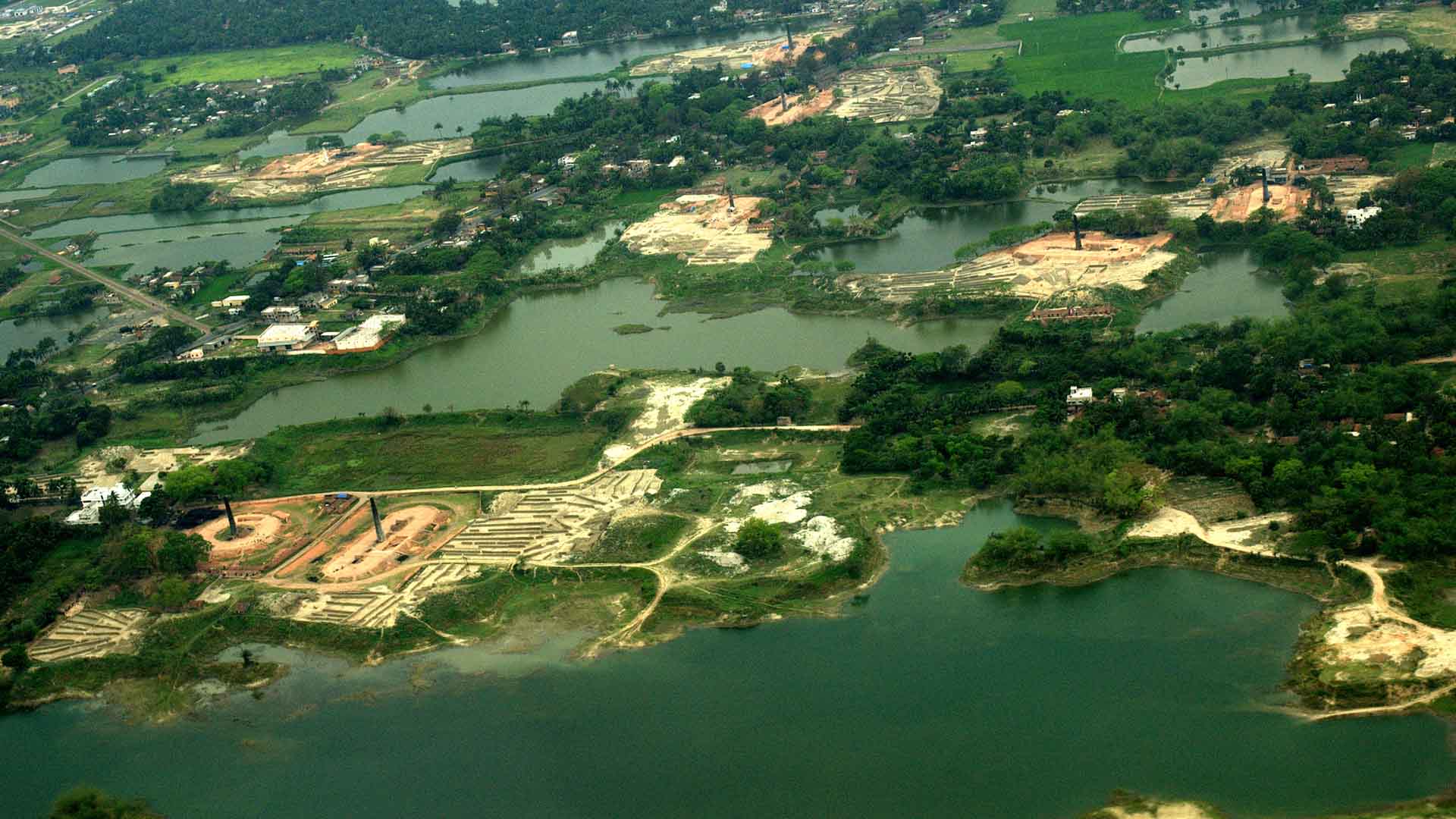
Calcutta still has a carbon sink in the East Kolkata Wetlands where some 60% of the city’s carbon is sequestered – file
Unfortunately, despite nature being central to many Indian cultures, breathing air that can be passable as clean, is becoming increasingly rare in the subcontinent’s cities. The idea has become as luxurious to most as my single estate tea. It’s no wonder that how popular it has become for Indians to holiday in places considered natural wonders not only for the scenery but also to breathe! Nature and yoga breaks have never been more popular among urbanites. And, it’s the same for Calcuttans, Delhiites, and Mumbaikers as it is may well be for New Yorkers.
So, the fact that Earth Day 2018 chose to focus on the elimination of plastics as its theme (not that this is unworthy) does little to address my predicament and that of those who also believe clean air should be a fundamental human right. This is all the more prescient when one considers that only five days ago, a report released by the US-based non-profit, Health Effects Institute, stated that India accounted for roughly 25% of all deaths related to air pollution in 2016. The report went on to say that India and China together accounted for half of all the number of healthy years lost in a person’s life due to air pollution. That’s a pretty damning indictment of the air over Asia’s biggest countries, so the emphasis of the Earth Day network on plastics seems to ring a little hollow in this part of the world.
It might not be all that surprising when one considers that in the past, Earth Day in India has been something of a joke – none greater than the year when an Earth Day tableau featured a taxi with a section of live lawn fitted to its roof and a jungle of potted plants crammed inside. The centerpiece then came to life and the driver drove the diesel-belching yellow Ambassador in a circle to the applause of a crowd apparently immune to irony!
It wasn’t always so. Founded in 1970 by Senator Gaylord Nelson of the United States and UN Secretary General U. Thant based on activism by John McConnell during the prior year to establish an occasion to commemorate the planet and peace, for decades, Earth Day actually mattered. The independently established US and UN Earth Day occasions, gave activists a rallying point to effect change, coincidentally (or not if you believe certain a certain conspiracy theory) on the 100th Anniversary of the birth of communist revolutionary, Vladamir Lenin.
Earth Day activism influenced the Nixon administration to establish the US Environmental Protection Agency – an organization now under siege by President Trump. Earth Day activists helped clean oil spills, put in place recycling programs – and planted trees in an attempt to restore the Earth’s Carbon sink.
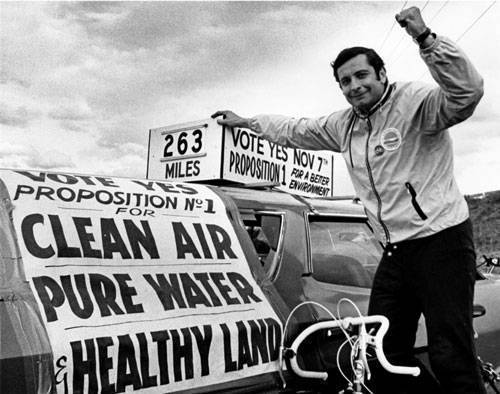
Early priorities of Earth Day – file
Today, the professional volunteer network that runs activities for the occasion is focused on education, promotion and event management. Not to minimize the value of these types of activities, the Earth Day rallies that prompted governments to change seem to have evolved (at least in this part of the world) into campy events with requisite dignitaries and common rituals like lamp lighting ceremonies as well as school projects largely cut and pasted from the internet, not to mention tweets.
Sill, I decided to search out a local Earth Day story that might fire up an optimistic flare through the murky smog of indifference that seems to hang over much of the city. The quest led me to an unlikely place, last Friday: Paribhan Bhavan, located in the heart of the city near Dalhousie Square where West Bengal’s Transport Department is located. There I met transport secretary and Managing Director of the West Bengal Transport Corporation (WBTC), Mr. Narayan Swaroop Nigam as well as Minister-in-Charge, (Hon.) Suvendu Adhikari.
Nigam, with the enthusiastic support of his minister and the Chief Minister of the State, Mamata Banerjee, seeks to implement a public transportation system by the year 2030 that will be virtually zero-emission. The Earth Day Network should sit up and take notice, for here is a government responding to the ghost of policy advocacy past – or more importantly, the desire by residents like me to breathe clean air!
The first step will be deploying a fleet of zero emission air-conditioned buses, planned for roll out as early as June. Forty buses will be inaugurated to operate in various parts of Calcutta to help reduce the city’s carbon footprint and leave residents breathing easier. Capacity of each coach is to range from 40-60 seats, depending on the model.
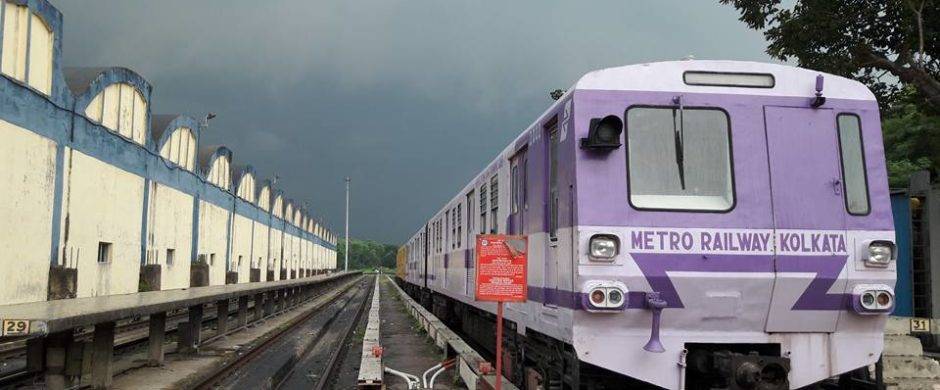
Calcutta’s Metro Rail System is the oldest in the country and offers zero-emission transit – source Govt. of West Bengal
With sixty percent of the funding coming from the Central government and the remainder earmarked from the state departmental budget, despite all the acrimonious political rhetoric making frequent headlines, Centre and State seem to be lock-in-step when it comes to lowering the carbon footprint of transit. I suppose the neither level of government wants to let down commuters and every eligible voter has lungs.
A similar pilot project for environmentally friendly buses or ‘e-buses’ as they’ve been called is already running in New Town, an increasingly ‘smart’ suburb north of Calcutta. The New Town project is just one of various innovations led by pubic official, Debashis Sen, Secretary of the Science and Technology Department and Chairman of the Housing and Urban Development Corporation (HIDCO).
The New Town Development Authority of which Sen is also chairman, is trying to introduce eco-friendly or e-rickshaws in the township that will run on batteries for short routes, providing a zero-emission alternative to traditionally high polluting three-wheelers. A plan for monorail service is also in the offing. The NTDA’s aim is to establish a modern and responsive public transport system for the township, which will be developed into a smart city. The vision entails having a personalized rapid transit system where vehicles will be pollution free, battery operated and will move on short routes.
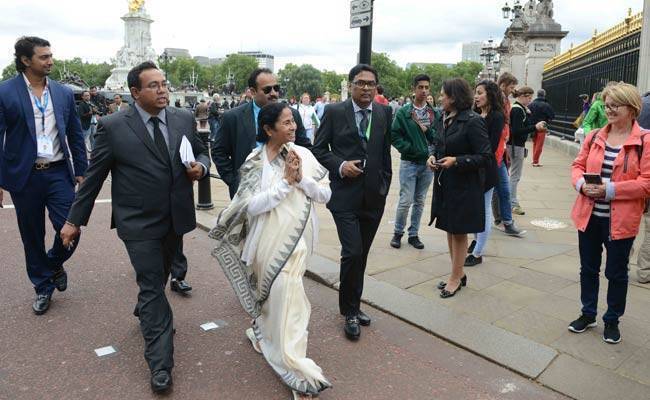
The inspiration for electric buses may have come from Hon. Chief Minister, Mamata Banerjee’s London trip in 2015 – file
As impressive the New Town initiatives and plans seem, the township hosts only a fraction of greater Calcutta’s commuters. So, Nigam’s challenge is somewhat more daunting, for the daily commute of over 9 million souls falls squarely under his charge.
As we chat at Nigam’s office in the old Calcutta Tramways building, the phones ring intermittently. Mid-sentence, the shrill of the red phone stiffens his spine, prompting him to hold up his finger to pause our chat. It is a phone call from the minister’s office asking about a bus accident on the outskirts of the city. Soon, his other hand cups a different phone, a stern look on his face. When the ministerial call concludes, he demands why the minister’s office has had to inform him of crash, calling for departmental officials to cooperate with emergency services to clear the road. Indeed, that the head of the state’s transport authority would get a call like this, indicates the extent to which he is carpet-bombed by issues each day. And the buck stops with him.
Despite the heavy responsibility and being forced into reactive mode more frequently than is desirable, remarkably, he retains a strategic focus – and that’s what the zero-emission program is all about – the future. It not only includes running electric buses but also a vast expansion of the metro. “A city such as Calcutta where people are not only commuting to the city centre for work but also have to go to Howrah and other places on the metropolitan outskirts, must rely on efficient functioning of inter-modal transport linking rail, bus and underground,’ says Nigam. He adds: ‘And, when we combine the goal of achieving zero-emission transit with easing congestion on roads, the metro becomes crucial to this,” says Nigam.
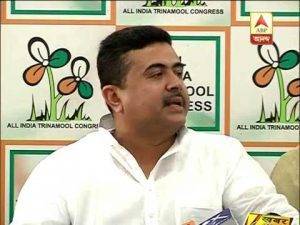
WB Transport Minister, (Hon.) Suvendu Adhikari (TMC) humbly attributes environmental progress to CM Banerjee
Nigam explains that currently the metro spans a 28 km corridor from north to south from Noapara to Garia. “So, we are currently lacking lateral tracks that many worldwide metro systems have,” says Nigam. In this, the Transport department must adjust to nature, which has created two natural barriers on the city’s wings: “Due to the peculiarity of the city, we are bound by the Ganga on the west and the East Calcutta Wetlands on the East, so to augment an already robust north-south corridor, we must add as much intermittent East-West connectivity as is feasible,” he adds.
This has already started with work going on to build a corridor from Howrah to Salt Lake Sector V, terminating at Haldiram Station. Another line is planned that would run parallel to the Eastern Metropolitan Bypass, which cuts through the most heavily trafficked zone in the city. The full expansion will take place in roughly four phases over the next two years with the first line planned for inauguration by mid-summer.
“We want to make it so that a person can get go from Dankuni or Howrah to all the major locations in the city – all by metro line, without causing any CFC emission or impacting traffic on the roads.” This would need around 100 km of new underground rail lines. “It is a long road but we are building it,” says Nigam.
The metaphor hangs as we are again interrupted by activity around the bus accident. Nigam is handed a written brief for the minister, and he invites me to walk and talk as he goes to meet the minister. After a five-minute wait during which Nigam briefs the Adhikari on the situation, behind closed doors, the Minister invites me in.
By this time, hearing a senior official of the Transport Department repeatedly talk about a goal of zero emissions is not only music to my ears but it is also something I scarcely thought believable even during the elevator ride to Nigam’s office. Needless to say, I never expected to be invited to meet the minister.
We shake hands and I explain that the MD and I had been talking about zero-emission transit, both e-bus and metro expansion. Minister Adhikari credits Chief Minister, Mamata Banerjee with the progress till date as well as the ambitious plans for expansion. “None of this would have been possible without Mamata-Didi,” he says. “Had she not laid the groundwork while she was Railways Minister (in the predecessor UPA Central Government), we would not have been able to develop the metro rail as we have.”
“We are trying to do new things,” proclaims Adhikari with a smile. “God-willing and with the energy and enthusiasm of our leader, the CM, we will succeed.”
Indeed, the electric bus initiative is said to have come from one of CM Banerjee’s trips to London in which she was impressed by the electric buses in Britain’s capital. Banerjee has famously pledged to use London as a model of what Calcutta could be. Many consider it to be an obsession resulting in a kitschy miniature Big Ben overlooking the EM Bypass and a Buckingham Palace themed puja pandal at one of last year’s seasonal festive displays. For others, the focus seems natural: Calcutta was, after all, the most important city in the British Empire after London during the heyday of The Raj; why shouldn’t it be restored to its former glory after successive Indian governments post-independence seemed to relish in the city’s decline?
Notwithstanding my cynicism and what has come to be a natural Bengali siege mentality, when CM, Mamata Banerjee was first elected, it seemed that populist priorities would take precedence over the environment. It may well be that the success of environmental promotion campaigns of which Earth Day is a part, has aligned populism with environmental protection, thereby getting politicians firmly onside. It’s an equation that heavy polluters, at last, might not be able to solve to their advantage. And if recent history has taught industry something, it is that when Mamata Banerjee sets her mind to something, opposing her in the state of West Bengal is as practical as pole vaulting Mount Everest!
Perhaps, it is in this that we can be most optimistic on Earth Day 2018 – that despite backward tendencies like burning garbage, with politicians and public officials working together to make the air breathable, the streets more traversable, and overall life more pleasant, a sea of change is bound to result.
While Transparency International (TI) has listed India as among the most corrupt countries in Asia, my Earth Day preamble demonstrated that, indeed, there are officials who are in earnest working to change things for the better. These people, surprisingly sincere, whom we can fairly call the new heroes of Bengal, offer hope that in the future the average Calcuttan won’t have to suffer a suffocating morning while having their morning tea on Earth Day as I did on April 22nd, 2018.
With that I look forward to Earth Day 2020 when fifty years of Earth Day will coincide with a myriad of development goals Indian officials have set for the nation. After years of being downcast, at long last, mine is an optimistic gaze.
Postscript: Earth Day will kick off Climate Education Week from April 23th -29th. More information as well as an education toolkit are available on the Earth Day Network’s Website.
 The Global Calcuttan Magazine
The Global Calcuttan Magazine
Earth Day: Burning Garbage Clouds Green Agenda
Posted by The Global Calcuttan on Sunday, April 22, 2018 · Leave a Comment
As Bengal’s Transport Department aims for zero-emission public transit, does Earth Day Network’s anti-plastics theme overshadow the daunting problem of air pollution?
SB VEDA <CALCUTTA>
Earth Day 2018 began inauspiciously for me as I choked on smoke from burning leaves while my morning ritual of imbibing the finest single estate Darjeeling tea was rudely interrupted. Apparently, the people who run Mahanirban Math, a sprawling green religious ground that virtually backs on to my property, decided the best way of disposing of their easily compostable debris was by setting it ablaze!
One of the reasons why I moved to India was to seek a simpler life than that typified by the Western rat race. Indians have long lived with nature – at least that’s what Central Government Environment Minister, Harsh Vardhan said when he co-announced with UN officials that India would host World Environment Day, this June. He was not wrong: India used to be what scientists call a Carbon sink with many forest, jungles and other green spaces sequestering carbon and removing it from the air through the natural metabolic process that plants undergo to essentially breathe.
Calcutta still has a carbon sink in the East Kolkata Wetlands where some 60% of the city’s carbon is sequestered – file
Unfortunately, despite nature being central to many Indian cultures, breathing air that can be passable as clean, is becoming increasingly rare in the subcontinent’s cities. The idea has become as luxurious to most as my single estate tea. It’s no wonder that how popular it has become for Indians to holiday in places considered natural wonders not only for the scenery but also to breathe! Nature and yoga breaks have never been more popular among urbanites. And, it’s the same for Calcuttans, Delhiites, and Mumbaikers as it is may well be for New Yorkers.
So, the fact that Earth Day 2018 chose to focus on the elimination of plastics as its theme (not that this is unworthy) does little to address my predicament and that of those who also believe clean air should be a fundamental human right. This is all the more prescient when one considers that only five days ago, a report released by the US-based non-profit, Health Effects Institute, stated that India accounted for roughly 25% of all deaths related to air pollution in 2016. The report went on to say that India and China together accounted for half of all the number of healthy years lost in a person’s life due to air pollution. That’s a pretty damning indictment of the air over Asia’s biggest countries, so the emphasis of the Earth Day network on plastics seems to ring a little hollow in this part of the world.
It might not be all that surprising when one considers that in the past, Earth Day in India has been something of a joke – none greater than the year when an Earth Day tableau featured a taxi with a section of live lawn fitted to its roof and a jungle of potted plants crammed inside. The centerpiece then came to life and the driver drove the diesel-belching yellow Ambassador in a circle to the applause of a crowd apparently immune to irony!
It wasn’t always so. Founded in 1970 by Senator Gaylord Nelson of the United States and UN Secretary General U. Thant based on activism by John McConnell during the prior year to establish an occasion to commemorate the planet and peace, for decades, Earth Day actually mattered. The independently established US and UN Earth Day occasions, gave activists a rallying point to effect change, coincidentally (or not if you believe certain a certain conspiracy theory) on the 100th Anniversary of the birth of communist revolutionary, Vladamir Lenin.
Earth Day activism influenced the Nixon administration to establish the US Environmental Protection Agency – an organization now under siege by President Trump. Earth Day activists helped clean oil spills, put in place recycling programs – and planted trees in an attempt to restore the Earth’s Carbon sink.
Early priorities of Earth Day – file
Today, the professional volunteer network that runs activities for the occasion is focused on education, promotion and event management. Not to minimize the value of these types of activities, the Earth Day rallies that prompted governments to change seem to have evolved (at least in this part of the world) into campy events with requisite dignitaries and common rituals like lamp lighting ceremonies as well as school projects largely cut and pasted from the internet, not to mention tweets.
Sill, I decided to search out a local Earth Day story that might fire up an optimistic flare through the murky smog of indifference that seems to hang over much of the city. The quest led me to an unlikely place, last Friday: Paribhan Bhavan, located in the heart of the city near Dalhousie Square where West Bengal’s Transport Department is located. There I met transport secretary and Managing Director of the West Bengal Transport Corporation (WBTC), Mr. Narayan Swaroop Nigam as well as Minister-in-Charge, (Hon.) Suvendu Adhikari.
Nigam, with the enthusiastic support of his minister and the Chief Minister of the State, Mamata Banerjee, seeks to implement a public transportation system by the year 2030 that will be virtually zero-emission. The Earth Day Network should sit up and take notice, for here is a government responding to the ghost of policy advocacy past – or more importantly, the desire by residents like me to breathe clean air!
The first step will be deploying a fleet of zero emission air-conditioned buses, planned for roll out as early as June. Forty buses will be inaugurated to operate in various parts of Calcutta to help reduce the city’s carbon footprint and leave residents breathing easier. Capacity of each coach is to range from 40-60 seats, depending on the model.
Calcutta’s Metro Rail System is the oldest in the country and offers zero-emission transit – source Govt. of West Bengal
With sixty percent of the funding coming from the Central government and the remainder earmarked from the state departmental budget, despite all the acrimonious political rhetoric making frequent headlines, Centre and State seem to be lock-in-step when it comes to lowering the carbon footprint of transit. I suppose the neither level of government wants to let down commuters and every eligible voter has lungs.
A similar pilot project for environmentally friendly buses or ‘e-buses’ as they’ve been called is already running in New Town, an increasingly ‘smart’ suburb north of Calcutta. The New Town project is just one of various innovations led by pubic official, Debashis Sen, Secretary of the Science and Technology Department and Chairman of the Housing and Urban Development Corporation (HIDCO).
The New Town Development Authority of which Sen is also chairman, is trying to introduce eco-friendly or e-rickshaws in the township that will run on batteries for short routes, providing a zero-emission alternative to traditionally high polluting three-wheelers. A plan for monorail service is also in the offing. The NTDA’s aim is to establish a modern and responsive public transport system for the township, which will be developed into a smart city. The vision entails having a personalized rapid transit system where vehicles will be pollution free, battery operated and will move on short routes.
The inspiration for electric buses may have come from Hon. Chief Minister, Mamata Banerjee’s London trip in 2015 – file
As impressive the New Town initiatives and plans seem, the township hosts only a fraction of greater Calcutta’s commuters. So, Nigam’s challenge is somewhat more daunting, for the daily commute of over 9 million souls falls squarely under his charge.
As we chat at Nigam’s office in the old Calcutta Tramways building, the phones ring intermittently. Mid-sentence, the shrill of the red phone stiffens his spine, prompting him to hold up his finger to pause our chat. It is a phone call from the minister’s office asking about a bus accident on the outskirts of the city. Soon, his other hand cups a different phone, a stern look on his face. When the ministerial call concludes, he demands why the minister’s office has had to inform him of crash, calling for departmental officials to cooperate with emergency services to clear the road. Indeed, that the head of the state’s transport authority would get a call like this, indicates the extent to which he is carpet-bombed by issues each day. And the buck stops with him.
Despite the heavy responsibility and being forced into reactive mode more frequently than is desirable, remarkably, he retains a strategic focus – and that’s what the zero-emission program is all about – the future. It not only includes running electric buses but also a vast expansion of the metro. “A city such as Calcutta where people are not only commuting to the city centre for work but also have to go to Howrah and other places on the metropolitan outskirts, must rely on efficient functioning of inter-modal transport linking rail, bus and underground,’ says Nigam. He adds: ‘And, when we combine the goal of achieving zero-emission transit with easing congestion on roads, the metro becomes crucial to this,” says Nigam.
WB Transport Minister, (Hon.) Suvendu Adhikari (TMC) humbly attributes environmental progress to CM Banerjee
Nigam explains that currently the metro spans a 28 km corridor from north to south from Noapara to Garia. “So, we are currently lacking lateral tracks that many worldwide metro systems have,” says Nigam. In this, the Transport department must adjust to nature, which has created two natural barriers on the city’s wings: “Due to the peculiarity of the city, we are bound by the Ganga on the west and the East Calcutta Wetlands on the East, so to augment an already robust north-south corridor, we must add as much intermittent East-West connectivity as is feasible,” he adds.
This has already started with work going on to build a corridor from Howrah to Salt Lake Sector V, terminating at Haldiram Station. Another line is planned that would run parallel to the Eastern Metropolitan Bypass, which cuts through the most heavily trafficked zone in the city. The full expansion will take place in roughly four phases over the next two years with the first line planned for inauguration by mid-summer.
“We want to make it so that a person can get go from Dankuni or Howrah to all the major locations in the city – all by metro line, without causing any CFC emission or impacting traffic on the roads.” This would need around 100 km of new underground rail lines. “It is a long road but we are building it,” says Nigam.
The metaphor hangs as we are again interrupted by activity around the bus accident. Nigam is handed a written brief for the minister, and he invites me to walk and talk as he goes to meet the minister. After a five-minute wait during which Nigam briefs the Adhikari on the situation, behind closed doors, the Minister invites me in.
By this time, hearing a senior official of the Transport Department repeatedly talk about a goal of zero emissions is not only music to my ears but it is also something I scarcely thought believable even during the elevator ride to Nigam’s office. Needless to say, I never expected to be invited to meet the minister.
We shake hands and I explain that the MD and I had been talking about zero-emission transit, both e-bus and metro expansion. Minister Adhikari credits Chief Minister, Mamata Banerjee with the progress till date as well as the ambitious plans for expansion. “None of this would have been possible without Mamata-Didi,” he says. “Had she not laid the groundwork while she was Railways Minister (in the predecessor UPA Central Government), we would not have been able to develop the metro rail as we have.”
“We are trying to do new things,” proclaims Adhikari with a smile. “God-willing and with the energy and enthusiasm of our leader, the CM, we will succeed.”
Indeed, the electric bus initiative is said to have come from one of CM Banerjee’s trips to London in which she was impressed by the electric buses in Britain’s capital. Banerjee has famously pledged to use London as a model of what Calcutta could be. Many consider it to be an obsession resulting in a kitschy miniature Big Ben overlooking the EM Bypass and a Buckingham Palace themed puja pandal at one of last year’s seasonal festive displays. For others, the focus seems natural: Calcutta was, after all, the most important city in the British Empire after London during the heyday of The Raj; why shouldn’t it be restored to its former glory after successive Indian governments post-independence seemed to relish in the city’s decline?
Notwithstanding my cynicism and what has come to be a natural Bengali siege mentality, when CM, Mamata Banerjee was first elected, it seemed that populist priorities would take precedence over the environment. It may well be that the success of environmental promotion campaigns of which Earth Day is a part, has aligned populism with environmental protection, thereby getting politicians firmly onside. It’s an equation that heavy polluters, at last, might not be able to solve to their advantage. And if recent history has taught industry something, it is that when Mamata Banerjee sets her mind to something, opposing her in the state of West Bengal is as practical as pole vaulting Mount Everest!
Perhaps, it is in this that we can be most optimistic on Earth Day 2018 – that despite backward tendencies like burning garbage, with politicians and public officials working together to make the air breathable, the streets more traversable, and overall life more pleasant, a sea of change is bound to result.
While Transparency International (TI) has listed India as among the most corrupt countries in Asia, my Earth Day preamble demonstrated that, indeed, there are officials who are in earnest working to change things for the better. These people, surprisingly sincere, whom we can fairly call the new heroes of Bengal, offer hope that in the future the average Calcuttan won’t have to suffer a suffocating morning while having their morning tea on Earth Day as I did on April 22nd, 2018.
With that I look forward to Earth Day 2020 when fifty years of Earth Day will coincide with a myriad of development goals Indian officials have set for the nation. After years of being downcast, at long last, mine is an optimistic gaze.
Postscript: Earth Day will kick off Climate Education Week from April 23th -29th. More information as well as an education toolkit are available on the Earth Day Network’s Website.
Category: Comment, Features, Uncategorized · Tags: air pollution, Calcutta, Climate Change, Earth Day, Kolkata, Kolkata Metro Rail, Mamata Banerjee, Suvendu Adhikari, WB Transport Department